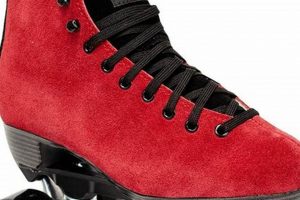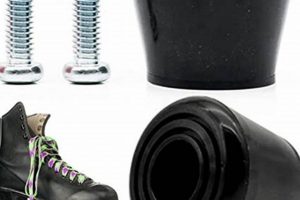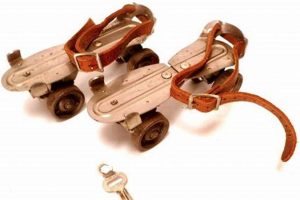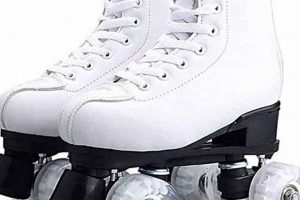The foundational component affixed to the bottom of a roller skate boot is responsible for connecting the wheels to the boot. This crucial element allows for controlled movement and maneuverability. As an example, consider the structure holding the wheels and axles that permits turns and provides stability during skating.
Its robust design directly influences the skater’s performance and safety. Throughout the history of roller skating, advancements in its materials and design have contributed significantly to improvements in speed, agility, and overall skating experience. Its selection is paramount to ensuring comfort, control, and longevity of the roller skates.
This article will explore the different types available, the materials used in their construction, the factors to consider when choosing a suitable one, and maintenance procedures to ensure optimal performance and durability. This examination will provide a comprehensive understanding of this critical skate component.
Guidance on Roller Skate Plates
The following recommendations offer insights into selecting and maintaining this critical piece of roller skate equipment, promoting optimal performance and longevity.
Tip 1: Material Selection: Prioritize materials like aluminum or magnesium alloy for a balance of strength and weight. These materials enhance responsiveness and reduce fatigue during extended use. For instance, a 7075 aluminum alloy is preferred for its high tensile strength.
Tip 2: Kingpin Angle Considerations: Understand the impact of the kingpin angle on maneuverability. Lower angles (e.g., 10 degrees) provide increased stability for speed skating, while higher angles (e.g., 45 degrees) enhance agility for dance and artistic skating.
Tip 3: Cushion Durometer Assessment: Evaluate the durometer of the cushions (or bushings) based on skating style and weight. Softer cushions offer greater flexibility for tighter turns, while harder cushions provide increased stability and support for larger skaters or high-speed applications.
Tip 4: Mounting Precision: Ensure proper mounting alignment of roller skate plates to the boot. Misalignment can lead to uneven wear on wheels and compromised balance, potentially causing instability and increasing the risk of injury.
Tip 5: Regular Inspection and Maintenance: Routinely inspect for signs of wear, cracks, or loose components. Regular cleaning and lubrication of pivot points and kingpins will maintain smooth operation and extend the lifespan.
Tip 6: Consider the wheelbase: A longer wheelbase generally provides more stability, while a shorter wheelbase offers greater maneuverability. Choose a wheelbase length that aligns with the intended skating style and skill level.
Tip 7: Research different brands: Not all roller skate plates are created equal. Research reputable brands known for quality craftsmanship and performance. Reading reviews and consulting with experienced skaters can provide valuable insights.
Adhering to these guidelines regarding material, setup, and upkeep will significantly influence skating experience, ensuring efficient transfer of energy and minimizing potential risks.
The next section will delve into the common issues encountered and troubleshooting methods for maintaining optimal functionality.
1. Material Composition
Material composition is a critical determinant of the performance and longevity of roller skate plates. The materials used directly influence the plate’s strength, weight, and ability to withstand stress and fatigue. For example, aluminum alloys are commonly chosen for their high strength-to-weight ratio, allowing for a lightweight yet durable structure. In contrast, steel, while stronger, adds considerable weight, which may impact agility and increase fatigue over extended use. The choice of material, therefore, represents a trade-off between these factors. For instance, a competitive speed skater might prioritize lightweight aluminum to reduce drag and enhance acceleration, while a recreational skater may prefer the more cost-effective and durable steel, even with the added weight.
Furthermore, the specific alloy used within a material class further refines the performance characteristics. A plate constructed from 7075 aluminum, for instance, offers superior tensile strength compared to a plate made from 6061 aluminum. This difference translates to increased resistance to bending or deformation under load, which is especially important for skaters performing complex maneuvers or those who subject their equipment to high levels of stress. The heat treatment process applied to the material also significantly impacts its properties. Specific examples in the skating world include plates reinforced with carbon fiber or incorporating titanium components to further enhance strength and reduce weight, though often at a higher cost.
In summary, material composition is a foundational aspect of roller skate plate design, influencing the plate’s overall performance, durability, and suitability for specific skating disciplines. Understanding the properties of different materials and alloys allows skaters to make informed decisions that align with their individual needs and skating style. The selection of materials impacts the price point and influences the performance of the wheel plates.
2. Kingpin Angle
The kingpin angle, integral to roller skate plate design, significantly influences a skater’s maneuverability and stability. Its orientation directly affects the responsiveness of the skate to weight shifts and directional changes, impacting performance across various skating disciplines.
- Definition and Measurement
The kingpin angle refers to the angle at which the kingpin the bolt connecting the trucks to the plate is positioned relative to the plate’s surface. This angle is typically measured in degrees, with common angles ranging from 10 to 45 degrees. A smaller angle positions the kingpin closer to vertical, while a larger angle tilts it further away.
- Impact on Stability and Maneuverability
Lower kingpin angles (e.g., 10-20 degrees) generally provide increased stability at higher speeds. This makes them suitable for speed skating and roller derby where maintaining a stable platform is crucial. Conversely, higher kingpin angles (e.g., 30-45 degrees) offer enhanced maneuverability and tighter turning radii. This is preferred in artistic skating and jam skating, where quick directional changes and intricate footwork are essential.
- Influence on Pivot Point and Lean
The kingpin angle directly affects the pivot point around which the skate turns. A higher angle results in a more pronounced lean into turns, allowing for deeper carving and sharper edges. This increased lean also requires greater ankle strength and control. A lower angle provides a more upright skating position, minimizing lean and maximizing stability.
- Compatibility with Skating Style
Selecting the appropriate kingpin angle is paramount for aligning the skate’s performance with the intended skating style. Mismatched angles can lead to instability, reduced agility, and increased fatigue. Skaters should consider their skating discipline, skill level, and personal preferences when choosing a plate with a specific kingpin angle.
In conclusion, the kingpin angle is a critical design element dictating the responsiveness and stability of roller skate plates. Its selection should be carefully considered to optimize performance and ensure compatibility with the skater’s specific needs and skating style. Adjustment of the kingpin is typically done by professionals.
3. Cushion Durometer
Cushion durometer plays a critical role in the performance characteristics of roller skate plates. The hardness of the cushions, measured by the durometer scale, directly impacts the skate’s responsiveness, stability, and overall feel. Appropriate selection is crucial for optimizing performance and catering to individual skating styles.
- Definition and Measurement
Durometer quantifies the hardness of a material. In the context of roller skate plates, it refers to the cushions (also known as bushings or rubbers) that sit between the plate and the trucks. The durometer scale typically used is the Shore A scale, with lower numbers indicating softer cushions and higher numbers indicating harder cushions. A cushion with a durometer of 78A is softer than one with a durometer of 95A.
- Impact on Turning and Responsiveness
Softer cushions allow for greater compression and deflection, resulting in a more responsive skate with tighter turning capabilities. This is often preferred by skaters who prioritize agility and maneuverability, such as those involved in artistic skating or roller derby. Conversely, harder cushions provide less compression, leading to a more stable and less responsive skate. This is beneficial for skaters seeking stability at higher speeds, such as speed skaters or those learning basic skills.
- Influence on Stability and Control
Harder cushions offer increased stability and control, especially at higher speeds. They resist unwanted movement and provide a more rigid platform, reducing the likelihood of “speed wobbles.” Softer cushions, while offering greater maneuverability, can feel less stable, especially for skaters who are not accustomed to the increased responsiveness. Finding the right balance between stability and responsiveness is crucial for optimal performance and safety.
- Compatibility with Skater Weight and Style
The ideal cushion durometer is influenced by skater weight and skating style. Heavier skaters typically require harder cushions to prevent excessive compression and maintain stability. Lighter skaters may prefer softer cushions to achieve the desired level of responsiveness. Similarly, skaters who engage in aggressive or high-impact skating may benefit from harder cushions to withstand the increased stress and prevent premature wear. Careful consideration of these factors is essential for selecting cushions that provide the appropriate level of support and performance.
The selection of cushion durometer directly impacts the functionality of roller skate plates, influencing both performance and user experience. Factors such as skater weight, preferred style, and desired balance of stability and maneuverability must inform the selection process. Experimentation and adjustment may be necessary to fine-tune the skate’s feel and optimize performance for individual needs.
4. Mounting Precision
Proper mounting of roller skate plates is paramount for achieving optimal performance, ensuring skater safety, and maximizing equipment longevity. Precision in this process minimizes biomechanical stress, prevents premature wear, and enhances the overall skating experience. Deviations from precise mounting protocols can lead to compromised control and increased risk of injury.
- Alignment and Weight Distribution
Precise mounting ensures proper alignment of the plate with the skater’s foot, promoting balanced weight distribution across all four wheels. Misalignment leads to uneven weight distribution, causing inconsistent turning, reduced stability, and accelerated wear on specific wheels. Correct placement positions the plate to coincide with the natural biomechanics of the foot, maximizing energy transfer and reducing strain. Example: Incorrect mounting can result in pronation or supination, leading to discomfort and potential long-term issues.
- Plate Centering and Boot Interface
Centering the roller skate plate on the boot is critical for achieving a stable and predictable skating experience. Precise centering minimizes lateral forces that can destabilize the skater, especially during high-speed maneuvers. A secure and flush interface between the plate and the boot is equally important. Gaps or uneven contact points create stress concentrations, weakening the bond and potentially leading to plate detachment or boot damage. Example: Failure to properly countersink mounting bolts can create pressure points that compromise the boot’s integrity.
- Impact on Turning Mechanics
The angle at which the roller skate plate is mounted significantly affects turning mechanics. Slight variations in mounting angle can alter the skate’s responsiveness, impacting agility and control. Precise alignment ensures that the trucks engage smoothly and predictably during turns, allowing the skater to maintain balance and execute maneuvers with precision. Example: A plate mounted slightly off-axis can cause the skate to pull in one direction, requiring constant corrective effort.
- Minimizing Stress and Equipment Longevity
Precise mounting minimizes stress on the plate, boot, and related components, extending the equipment’s lifespan. Misaligned plates create unnatural forces that can lead to cracking, bending, or loosening of fasteners. Correct installation distributes stress evenly across the mounting surface, reducing the risk of fatigue failure and ensuring long-term durability. Example: Improperly tightened mounting hardware can lead to plate slippage, damaging the boot and potentially causing a hazardous situation.
In summary, meticulous attention to mounting precision is essential for realizing the full potential of roller skate plates. Proper alignment, centering, and secure attachment contribute to enhanced performance, improved safety, and extended equipment life. Deviation from best practices compromises the integrity of the skate system and increases the risk of adverse outcomes.
5. Wheelbase Length
Wheelbase length, the distance between the front and rear axles on roller skate plates, profoundly influences maneuverability, stability, and overall skating feel. This attribute necessitates careful consideration as it fundamentally shapes the skater’s experience.
- Maneuverability Trade-offs
A shorter wheelbase enhances agility and allows for tighter turns. This configuration suits dance and jam skating, facilitating rapid directional changes. Conversely, a longer wheelbase diminishes maneuverability but increases stability, making it preferable for speed skating or recreational use where maintaining a straight line is paramount. The choice represents a trade-off between agility and stability.
- Stability Enhancement
A longer wheelbase provides a more stable platform, reducing the likelihood of wobbles at higher speeds. This increased stability stems from a greater resistance to rotational forces. Skaters prioritizing stability, such as beginners or those engaging in speed skating, often benefit from a longer wheelbase. This design minimizes the effect of minor imbalances, promoting a smoother ride.
- Impact on Weight Distribution
Wheelbase length affects the distribution of weight across the four wheels. A longer wheelbase typically distributes weight more evenly, enhancing stability. A shorter wheelbase may concentrate weight towards the center, increasing responsiveness but potentially sacrificing stability. Understanding this relationship is crucial for optimizing performance and comfort.
- Influence on Skating Style
The chosen wheelbase length should align with the intended skating style. Aggressive skaters performing tricks may prefer a shorter wheelbase for increased agility. Conversely, distance skaters prioritize stability and efficiency, often opting for a longer wheelbase. The selection process necessitates a clear understanding of the skater’s goals and preferences.
The implications of wheelbase length are significant for roller skate plates. By carefully considering the trade-offs between maneuverability and stability, skaters can select plates that best suit their individual needs and skating style. The relationship between wheelbase length and skating performance underscores the importance of informed decision-making when selecting roller skate equipment.
6. Plate Weight
The weight of roller skate plates exerts a direct influence on a skater’s performance, agility, and endurance. Heavier plates require more energy to maneuver, potentially leading to fatigue and reduced responsiveness. Conversely, excessively lightweight plates may compromise structural integrity, impacting stability and potentially increasing the risk of equipment failure. The optimal plate weight represents a balance between durability and maneuverability, tailored to the specific skating discipline. For example, a speed skater might favor lightweight plates to minimize inertia and maximize acceleration, while a roller derby player may prioritize heavier, more robust plates to withstand the impacts and stresses of the sport.
The materials used in construction directly correlate with plate weight. Aluminum alloys, commonly employed, offer a favorable strength-to-weight ratio, making them a popular choice for various skating styles. Magnesium alloys represent an even lighter alternative but may sacrifice some durability. Steel, while heavier, provides exceptional strength and resistance to wear. Carbon fiber composites, though expensive, offer the lightest option with excellent stiffness. The selection of material necessitates a careful consideration of these factors, aligning plate weight with the intended use and the skater’s physical capabilities. The weight of this structure is also impacted by the design, if the plate is hollow it will be light but also reduce strength.
Ultimately, understanding the impact of plate weight is crucial for selecting roller skate plates that optimize performance and minimize fatigue. Choosing the appropriate weight requires careful consideration of skating style, physical capabilities, and material properties. While minimizing weight can enhance agility, sacrificing structural integrity may compromise safety and long-term durability. Striking a balance between these factors ensures a positive skating experience and minimizes the risk of equipment-related issues. Weight also influences the overall stability of the skates.
7. Pivot Action
Pivot action, a critical characteristic of roller skate plates, dictates the responsiveness and fluidity of turning. It refers to the degree to which the trucks can pivot relative to the plate, influencing the skater’s ability to initiate and execute turns with precision. Understanding pivot action is fundamental for skaters seeking to optimize performance and tailor their equipment to specific skating styles.
- Kingpin Inclination and Pivot Cup Interaction
Kingpin inclination is a key determinant of pivot action. A steeper kingpin angle allows for a greater range of truck movement, resulting in a more responsive pivot. The pivot cup, typically made of urethane, cushions the interface between the truck and the plate, influencing the smoothness and resistance of the pivot action. Denser pivot cups offer more resistance and stability, while softer pivot cups allow for a looser, more fluid feel. Examples include plates designed with adjustable kingpin angles to fine-tune pivot action and pivot cups of varying durometers to customize the skating experience.
- Truck Design and Hanger Geometry
The design of the trucks, specifically the hanger geometry, plays a crucial role in determining pivot action. Trucks with a steeper angle of attack allow for a more direct and responsive pivot, while those with a shallower angle provide greater stability and control. The width of the hanger also affects pivot action, with wider hangers offering increased stability and narrower hangers promoting quicker turning. As an example, short trucks offer a controlled rotation while long trucks offer high speed rotations.
- Influence of Cushion Durometer on Pivot
Cushion durometer significantly impacts pivot action. Softer cushions allow for greater truck movement, resulting in a looser and more responsive pivot. Harder cushions restrict truck movement, providing a more stable and controlled pivot. Skaters often experiment with different cushion durometers to fine-tune the pivot action to their preference. Using harder cushions often allow the user to learn the motions more easily.
- Impact on Turning Radius and Edge Control
The degree of pivot action directly influences turning radius and edge control. A more responsive pivot allows for tighter turns and quicker directional changes, while a more stable pivot provides greater control and precision. Skaters must consider their skating style and the demands of their chosen discipline when selecting plates with a specific pivot action characteristic. For example, dance skaters often prefer a more responsive pivot for executing intricate footwork, while speed skaters prioritize stability for maintaining control at high speeds.
Pivot action is a multifaceted aspect of roller skate plate design, influencing turning performance and overall skating experience. By understanding the interplay between kingpin inclination, truck design, cushion durometer, and their impact on turning radius and edge control, skaters can make informed decisions when selecting plates that align with their individual needs and skating style.
Frequently Asked Questions About Roller Skate Plates
This section addresses common inquiries regarding the selection, maintenance, and performance characteristics of roller skate plates. The information presented aims to clarify prevalent misconceptions and provide factual guidance.
Question 1: What constitutes a suitable material for roller skate plates?
The selection of material must consider the trade-off between weight, strength, and cost. Aluminum alloys are prevalent, offering a balance between these factors. Steel provides superior strength but adds weight. Composite materials, such as carbon fiber, offer minimal weight but may incur a higher cost. The skating discipline and skater’s proficiency should guide the material selection process.
Question 2: How does kingpin angle influence skating performance?
Kingpin angle affects the turning radius and stability. Lower angles promote stability at higher speeds, suitable for speed skating. Higher angles enhance maneuverability, beneficial for dance or artistic skating. Selecting the appropriate angle is crucial for aligning the equipment with the intended skating style.
Question 3: What role does cushion durometer play in skate functionality?
Cushion durometer influences the responsiveness of the skate. Softer cushions facilitate easier turning but may reduce stability. Harder cushions provide greater stability but may require more effort to initiate turns. Skater weight and desired responsiveness should inform the durometer selection.
Question 4: Why is precise mounting of roller skate plates essential?
Accurate mounting ensures proper weight distribution, prevents uneven wear, and optimizes energy transfer. Misalignment can lead to instability, discomfort, and premature equipment failure. Professional installation is recommended to ensure precise alignment.
Question 5: How does wheelbase length affect skating dynamics?
Wheelbase length impacts maneuverability and stability. Shorter wheelbases enhance agility, while longer wheelbases promote stability. The selection of wheelbase length should align with the skater’s preferred style and skill level.
Question 6: What maintenance procedures are recommended for roller skate plates?
Regular inspection for cracks, loose components, and wear is essential. Cleaning and lubrication of pivot points and kingpins maintain smooth operation. Replacement of worn cushions or pivot cups ensures optimal performance and extends equipment lifespan.
In conclusion, the proper selection, mounting, and maintenance of roller skate plates are critical for maximizing performance, ensuring safety, and extending equipment longevity. Consideration of material properties, kingpin angle, cushion durometer, wheelbase length, and regular maintenance contributes to an optimized skating experience.
The following section explores potential problems encountered and troubleshooting techniques for maintaining peak performance.
Roller Skate Plates
The preceding analysis has explored the critical aspects of roller skate plates, encompassing material composition, kingpin angle, cushion durometer, mounting precision, wheelbase length, plate weight, and pivot action. These elements collectively determine the performance characteristics, stability, and durability of roller skates. A comprehensive understanding of these factors is essential for informed equipment selection and maintenance.
Skaters are encouraged to apply this knowledge to optimize their equipment choices and prioritize regular maintenance. The continued development of materials and designs promises further advancements in roller skate plate technology, potentially enhancing performance and safety. Rigorous application of these principles can improve longevity and performance.







